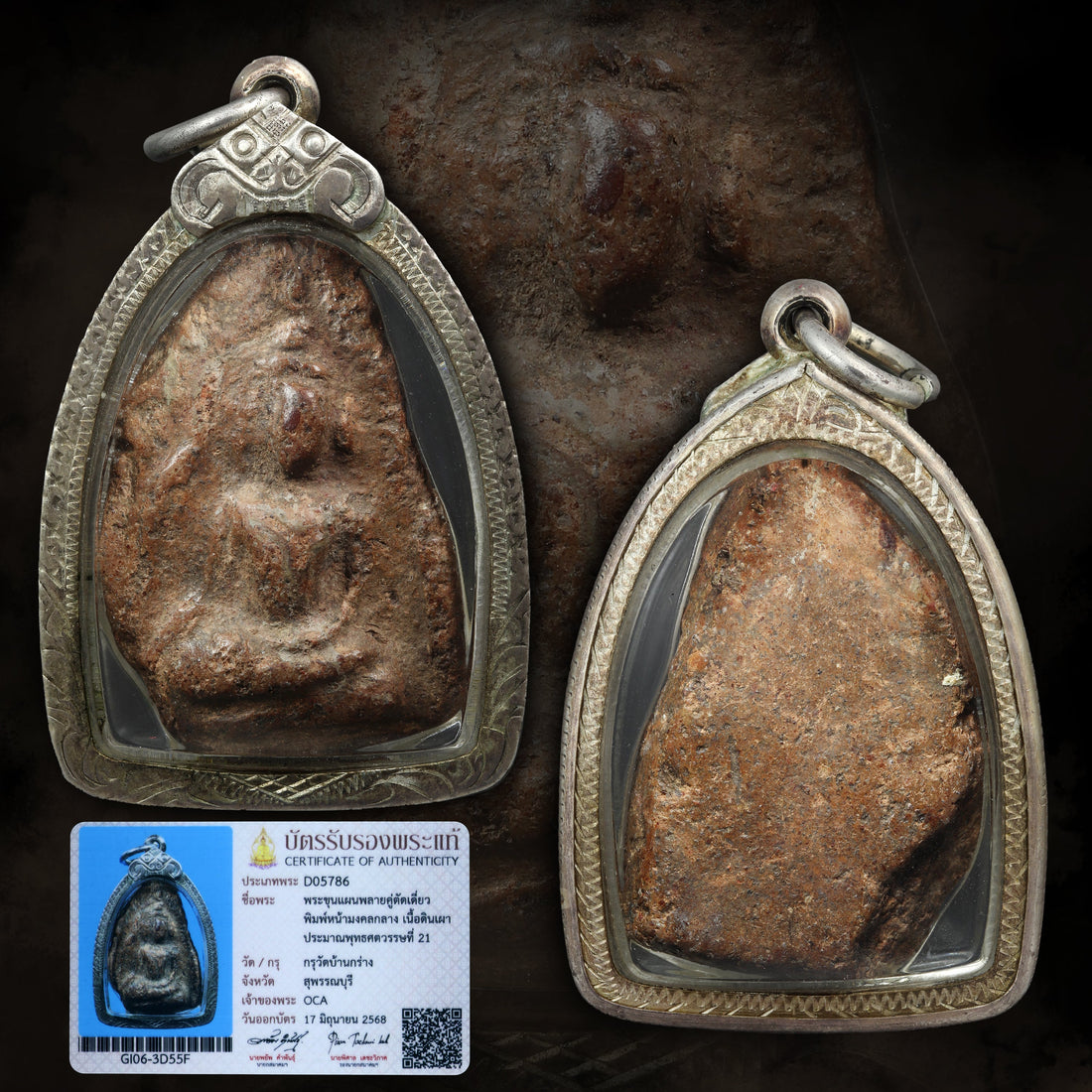Phra Khun Phaen, Wat Ban Krang – Origins, Lineage, and Characteristics
Origin Site: Wat Ban Krang, Si Prachan District, Suphanburi Province
Estimated Period of Construction: Middle Ayutthaya Era
Primary Discovery Date: Circa B.E. 2447 (c. 1904 CE)
Estimated Quantity: Approximately 84,000 pieces
Material: Sacred baked clay with visible mineral content
Iconography Style: Classic Ayutthaya sculptural aesthetics
Historical Context
The amulets known today as Phra Khun Phaen Wat Ban Krang originate from an ancient reliquary site located at Wat Ban Krang, situated along the eastern bank of the Tha Chin River in Suphanburi. These amulets were first discovered in the early 20th century, unearthed from the rear chedi behind the old viharn of the temple. The site itself dates back to the Ayutthaya period, and the craftsmanship aligns closely with mid-Ayutthaya Buddhist art.
Originally, these pieces bore no formal designation. Locals and monks who encountered them referred to them simply as “Phra Ban Krang” or by formation—such as “Phra Ban Krang Deaw” (single amulet) or “Phra Ban Krang Koo” (pair of amulets). The name “Phra Khun Phaen” was later attributed by collectors and historians due to thematic similarities with the legendary literary figure Khun Phaen from the Khun Chang-Khun Phaen epic, a tale set in the Suphanburi region.
Pim Variations and Artistic Value
Over 30 distinctive pim (mold types) have been identified, with notable examples including:
Pim Ha Liam Ok Yai (Large Chest, Five-Sided Mold)
Pim Song Phon Yai (Large Warrior Form)
Pim Khaen On (Soft Arm Mold)
Phlai Koo / Phlai Deaw (Twin/Single)
These formations reflect advanced clay casting techniques and deep understanding of religious iconography of the Ayutthaya craftsmen.
The aesthetic signature of the Ban Krang pieces—particularly the “Ok Yai” types—is defined by features such as elongated head spikes (kesa), curved hairline ridges, large eyes, curved mouth (osatha), and differentiated earlobe structures.
These traits exhibit clear relation to the Khun Phaen Khlueab (glazed) amulets from Wat Yai Chai Mongkhon in Ayutthaya, believed to have been cast by the same lineage of artisans or during the same royal patronage period under King Naresuan (B.E. 2135).
Spiritual Functions and Significance
Khun Phaen amulets from Wat Ban Krang are traditionally recognized for their triple domain of spiritual efficacy:
Metta Mahaniyom (Loving-kindness and Charisma)
Klaew Klaad (Avoidance of Danger)
Kongkraphan Chatree (Invulnerability and Protection)
These attributes made them widely sought-after by traders, warriors, and officials in historical central Thailand. The reputation of this batch remains strong among both field users and collectors, with high regard for the spiritual balance between metta and protective power.
Artisan Heritage and Technical Differentiation
Whereas the Khun Phaen Khlueab of Ayutthaya utilized refined white powder mixed with clay and glazed finish, the Ban Krang variety is created from coarse clay rich in mineral specks. Despite the difference in base material, both share near-identical sculptural features, suggesting a shared lineage in mold design or influence from the same regional artistic school.
This strongly implies that the same master craftsmen or monastery-backed workshops were commissioned across temple sites to create votive tablets in honor of royal military victories and merit dedication, especially in celebration of King Naresuan’s elephant duel triumph.
While Phra Khun Phaen from Wat Ban Krang was historically distributed to warriors preparing for armed conflict. These amulets were part of actual wartime readiness, especially during regional clashes across central Thailand. Soldiers who wore them were known for achieving victory, supported by qualities enhanced through the amulet—protection, charm, courage, and resilience. This is rooted in the Thai spiritual concept of baramee, referring to one’s accumulated spiritual strength or merit.
The tradition continues in modern military practice. Before deployment to high-risk border zones, Thai armed forces regularly send troops to receive blessings and empowered amulets from respected monks and spiritual masters. This process reinforces inner stability, mental focus, and the unseen layer of energetic protection needed in unpredictable situations.
In today’s world, the form of battle has changed. Business negotiations, job interviews, public-facing roles, and interpersonal challenges are the modern battlegrounds. In each of these, strength of presence, mental clarity, and timing decide the outcome. These traits are supported by baramee, and amulets from Ban Krang and other traditional sources continue to serve as spiritual tools for those navigating high-pressure environments.
These amulets carry the accumulated energy of centuries of use in high-stakes settings—first in war, now in leadership, commerce, and influence. Their function remains the same: to fortify the individual for decisive moments.
Translated and written by Old City Amulet (Pls credit if using my work)
